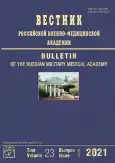Artificial intelligence using for medical diagnosis via implementation of expert systems
- Authors: Kotiv B.N.1, Budko I.A.2, Ivanov I.A.3, Trosko I.U.4
-
Affiliations:
- Military Medical Academy named after S.M. Kirov
- Russian Academy of National Economy and Public Administration under the President of the Russian Federation
- PharmPatent Limited Liability Company
- Stock Company RT LABS
- Issue: Vol 23, No 1 (2021)
- Pages: 215-224
- Section: Literature reviews
- URL: https://journals.rcsi.science/1682-7392/article/view/63657
- DOI: https://doi.org/10.17816/brmma63657
- ID: 63657
Cite item
Abstract
Modern biomedical technologies development affords to provide the doctor with colossal amount of information about patient’s organism condition. However, the opportunity of using this data for medical diagnosis fully now is a distantive perspective only. The reason is a human’s limited ability in assessment and interpretation this data arrays. The solution seems in artificial intelligence and expert systems wide introduction to medicine. Currently, almost all authors consider various options for constructing artificial neural networks as a way to implement artificial intelligence. This approach, which goes back to the fundamental theorem of A.N. Kolmogorov, the works of V.I. Arnold and Hecht-Nielsen [3], demonstrates excellent capabilities in a number of pattern recognition problems, which are reduced to revealing hidden details against the background of input noises. Much less often is mentioned such a method of modeling formal thinking as expert systems, which arose in the 1960s and then went into the shadows. Since the inception of cybernetics, computer programmers have tried to reproduce the mechanism of human thinking, that is, the task was to teach the computer to "think". The first known results in the field of creating and using intelligent systems were laid by the work of Norbert Wiener and G.S. Altshuller. At the same time, the creation of intelligent systems was reduced to the development of programs that solve problems using a variety of heuristic methods based on the property of human thinking to generalize.
Full Text
##article.viewOnOriginalSite##About the authors
B. N. Kotiv
Military Medical Academy named after S.M. Kirov
Author for correspondence.
Email: vmeda-nio@mil.ru
doctor of medical, sciences associate professor
Russian Federation, Saint PetersburgIgor A. Budko
Russian Academy of National Economy and Public Administration under the President of the Russian Federation
Email: beerd@inbox.ru
candidate of technical sciences
Russian Federation, Saint PetersburgIgor A. Ivanov
PharmPatent Limited Liability Company
Email: iia3@yandex.ru
candidate of medical sciences
Russian Federation, Saint Petersburg,Igor U. Trosko
Stock Company RT LABS
Email: troskoigor@gmail.com
lead implementation engineer
Russian Federation, Saint PetersburgReferences
- Kolmogorov AN. O predstavlenii nepreryvnyh funkcij neskol’kih peremennyh superpozicijami nepreryvnyh funkcij men’shego chisla peremennyh AN Kolmogorov. Izvestija AN SSSR. 1956;2(108):179–182. (In Russ.)
- Arnol`d VI. O funkcii treh peremennyh. VI Arnol`d. Izvestija AN SSSR. 1957;9(114):679–681. (In Russ.)
- Hecht-Nielsen R. Kolmogorov’s Mapping Neural Network Existence Theorem. R Hecht-Nielsen. IEEE First Annual Int. Conf. on Neural Netwoks, San Diego. 1987;3:11–13.
- Kruglov VV. Iskusstvennye nejronnye seti. Teoriya i praktika. 2-e izd., stereotip. VV Kruglov, VV Borisov. Moscow: Goryachaya liniya-Telekom; 2002;382. (In Russ.)
- Viner N. Kibernetika. N Viner. Moscow: Nauka; 1983. (In Russ.)
- Altshuller GS, et al. Poisk novyx idej: ot ozareniya k texnologii. Kishinyov: Kartya moldovenyaske; 1989. 111 p. (In Russ.)
- Ekspertnye sistemy. Principy raboty i primery. Ed. by R. Forsajta. Moscow: Radio i svyaz; 1987. (In Russ.)
- Gavrilova TA, Xoroshevskij VF. Bazy` znanij intellektual`ny`x system. Saint Petersburg: Piter; 2000. 384 p. (In Russ.)
- Uotermen D. Rukovodstvo po e`kspertny`m sistemam. Moscow: Mir; 1989. (In Russ.)
- Dzhekson P, Piter P. Vvedenie v e`kspertny`e sistemy`. Moscow: Vil`yams; 2001. (In Russ.)
- Predstavlenie i ispol`zovanie znanij. Ed. by X. Ue`no, M. Isidzuka. Moscow: Mir; 1989. (In Russ.)
- Kazancev AP. Differencial`naya diagnostika infekcionny`x boleznej. Moscow: MIA; 1999. 482 p. (In Russ.)
- Lezhenko A. On the Methods of Formalization of the Information Treads and Data Processing in Integrated Information and Telecommunication Technologies. 8th Multi-Conference on Systemic. Cybernetics and Informatics (SCI 2004). Orlando, Florida, USA; 2004. P. 180–185.
- Mizumoto M, Gupta MM, Ragade RK, Yage RR. Some methods of fuzzy reasoning. Advances in Fuzzy Set Theory Applications. North-Holland, Amsterdam. 1979;253–283.
- Kumar A. Dr. Sanjay Kumar Study and Analysis of MYCIN expert system. International Journal of Engineering and Computer Sience. 2015;4(10):14861–14865.
- Buchanan BG, Shortliffe EH. Rule-based Expert Systems: The МYСIN Experiments of the Stanford Heuristic Programming Project. Addison-Wesley. Reading, MA; 1984.
- Ambalov YuM. Algoritm provedeniya differencial`noj diagnostiki. Yu.M. Ambalov. Uspexi sovremennogo estestvoznaniya. 2003;8:34–34. (In Russ.)
- Serobabov AS, et al. Razrabotka e`kspertnoj sistemy` rannej diagnostiki zabolevanij: programmny`e sredstva pervichnoj obrabotki i vy`yavlenie zavisimostej. Omskij nauchn. vestn. 2018;4(160):179–184. (In Russ.)










